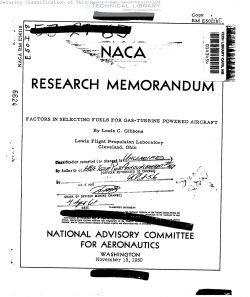naca-rm-e50i18
- Version
- 53 Downloads
- 3.72 MB File Size
- 1 File Count
- April 24, 2017 Create Date
- April 24, 2017 Last Updated
National Advisory Committee for Aeronautics, Research Memorandum - Factors in Selecting Fuels for Gas-Turbine Powered Aircraft

This report briefly summarizes some of the available information
on fuels for gas-turbine powered aircraft. The effects of fuel
volatility and composition on the range, reliability, and safety of
aircraft are discussed. Availability is briefly considered for fuels
at various volatility levels.
The development of gas-turbine engines and their application to
aircraft has been a very rapidly changing process. Along with the
mechanical development of aircraft gas-turbine engines, it has been
necessary to acquire a knowledge of the fuel requirements of the
engines and the requirements and limitations of fuel systems for high-
speed aircraft. It has also been necessary to continually revise the
estimated quantities of Jet fuel required for an air force with a
constantly changing ratio of gas-turbine to reciprocating engines.
As the requirements of the Jet fuel have become more apparent,
the specifications have been changed from AN-F-SZ (JP-l), to AN—F-34
(JP-2), to AN-F-58 (JP—5), to AN-F-58a, and to MIL-F-5624. As new
knowledge of aircraft requirements becomes available, it will probably
be necessary to continue to revise the Jet-fuel specification. The
establishment of a specification requires consideration of the effects
of fuel composition and volatility on engine performance and on the
fuel system of the airplane. It is also necessary to consider the
quantity of fuel required and other variables such as the hazards
entailed in transporting and handling the fuel.
Some of the factors that must be considered in the selection of a
fuel for gas-turbine aircraft are briefly discussed and the areas where
additional information is required are indicated herein. The topics to
be conSidered are given in figure 1. Inasmuch as some of these topics
have been treated in numerous papers, the subjects are discussed very
briefly and a few representative data are presented to illustrate the
problems under discussion.
| File | Action |
|---|---|
| naca-rm-e50i18 Factors in Selecting Fuels for Gas-Turbine Powered Aircraft.pdf | Download |

Comment On This Post